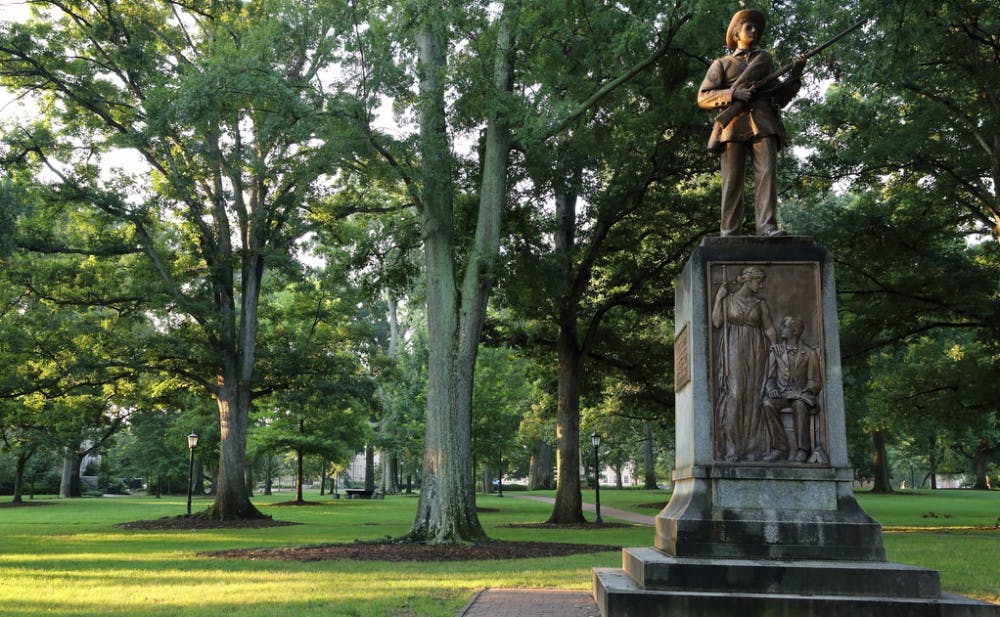University of North Carolina-Chapel Hill and Duke students are unlikely allies, but some stood together to counter-protest a Thursday vigil for the fallen Silent Sam statue.
The bronze statue of a Confederate soldier once stood at the main entrance of the University of North Carolina at Chapel Hill until protestors toppled it Aug. 20. A vigil was held for the fallen statue Thursday, and a cohort of Duke students joined the counterprotesters.
“A lot of this is Jim Crow. I think there are multiple symbolic resonances with tearing something like this down," senior Aaron VanSteinberg said. "It’s not only a rejection of this glorification of the Confederate States of America that created itself to uphold a massively violent institution of slavery who would be on par with any genocidal event in history.”
Senior Gabe Brumagin said he joined the counter-protesters to prevent "white supremacists" from having a platform. Duke senior Zoe Abedon had a different experience, describing the protest as almost jovial, saying there was a “dance party of sorts" taking place.
"They were playing some Fall Out Boy anthems," she said. "They tried to keep the tone of the counter protest at least—light’s not the right word—but joyful in a way because you are counter protesting against something extremely hateful. We outnumber you, we are out here having a good time.”
There was a large police presence at the protest. Brugamin said he was worried that the police would take the side of the white supremacist rally-goers over the counter-protesters.
VanSteinberg was afraid of the police, who he said pepper-sprayed the crowd.
“That’s the first time that I have very understood that millions and millions of people in this country are afraid of the cops, and have good reason to be," he said. "Armed people walking around with essentially legal precedent to kill people in certain situations in the name of ‘justice.’”
Junior Caroline Waring said she unnerved by a Confederate flag with a machine gun and the words "come and get it" printed on it, but also stressed that there was anger coming from both sides.
Van Steinberg asserted that he is already familiar with the discourse of white supremacy, being from Oklahoma. He mocked the “throbbing distended reason” of those who argue for free speech on all sides.
“The unreasonable thing to be here is objective or to think that this is a situation for chin scratching,” he said.
Ivy Drew—a first-year at North Carolina—was disgusted by the statue. She said she participated in the protest because of Julian Carr’s dedication speech of the statue in 1913. Carr recalled how he whipped a black woman who insulted a white “Southern lady.”
For Drew, the statue didn't just signify white supremacy in the South.
“The dedication speech of this monument, it was to remind the black woman, the black witch of her place in society,” she said.
Carr's name currently adorns the Carr Building on Duke' East Campus, a name Duke's history department recently requested to be changed.
Waring said that the social justice victory of removing Silent Sam has invigorated student activists in the region, gaining momentum with the further “renunciation of the history of white supremacy."
The students said Duke students need to get more involved in the region's politics.
“It is a privilege to not be politicized,” Brumagin said.
The students all agreed that they would like to see more cooperation between Duke and UNC in tackling such issues.
As of now, Drew is anticipating North Carolina Chancellor Carol Folt’s final decision on the placement of Silent Sam, which will be released Nov. 15.
Get The Chronicle straight to your inbox
Sign up for our weekly newsletter. Cancel at any time.
She hopes the statue will be removed, but while still acknowledging its history.
“History can be remembered and thought upon and it's not an erasure of history if we take down the statue," she said. "It is an erasure of white supremacy and the notion of that my existence on campus will not be of value.”

